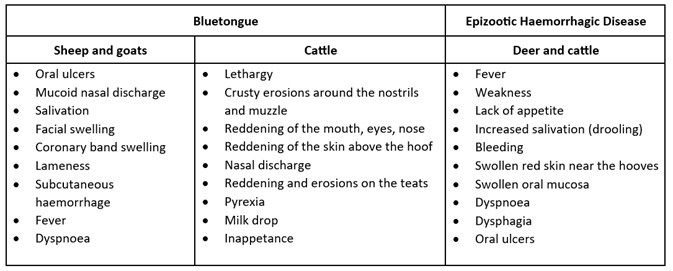Bluetongue and Epizootic haemorrhagic disease update
Bluetongue and Epizootic Haemorrhagic Disease are viral diseases circulating in Europe that are a risk to UK cattle and sheep, with both being notifiable in the UK. Both of these viruses are species of the Orbivirus genus and are transmitted between animals by midges.
Bluetongue
Bluetongue Virus (BTV) has been circulating in European countries for some time. Outbreaks of bluetongue were seen in the UK in 2007, and there were cattle imported into England and Scotland back in 2017 that tested positive for bluetongue on post-import testing. However, on 5 September 2023, the Netherlands reported their first outbreak of Bluetongue since 2009 and there have now been over 1000 confirmed outbreaks, mostly on sheep farms. The strain currently circulating in the Netherlands has been confirmed to be BTV-3.
Additionally, on 21 September 2023, France confirmed the presence of a new strain of Bluetongue serotype 8 (BTV-8) which is causing more severe clinical signs in cattle and sheep than previously seen with this strain.
In addition to cattle, sheep and goats, wild ruminants and New World camelids (alpacas, llamas) are susceptible to infection with bluetongue.
Epizootic haemorrhagic disease
Epizootic Haemorrhagic Disease (EHD), caused by Epizootic Haemorrhagic Disease virus, was confirmed for the first time in Europe in October 2022 in Italy. It has since spread to Portugal, Spain and the south of France but over the last couple of weeks there has been a significant increase in number of cases in France. EHD affects deer most severely, but disease has been reported in cattle at multiple farms in these countries. This disease has not previously been seen in the UK.
Spread
Both diseases are transmitted between animals by biting midges and therefore spread of the disease is more likely during the midge season. The virus does not infect humans. As midges are still active, there is concern that infected midges could be blown across the channel to the UK and pose a risk to UK livestock and deer. The south and east coast of England are at greatest risk. There is also a risk of incursion to the UK from infected imported animals and germplasm (embryos, semen etc).
The table below summarises the clinical signs.

Infection of pregnant cattle and sheep may result in:
- Early embryonic death
- Abortions
- Birth of small, weak or malformed animals
What can farmers do?
- Be extra vigilant for any signs of clinical disease as detailed in the table above that could be associated with bluetongue or enzootic haemorrhagic disease
- Report any suspicion of these diseases immediately
- Source animals responsibly if importing from European countries
- Source germplasm (embryos, semen etc) responsibly and be aware of the disease status of exporting countries and collection centres
- Be aware of the current disease situation in exporting countries
- Request a PCR test for bluetongue and enzootic haemorrhagic disease before animals are imported
- Ensure any animals that are imported have the correct paperwork and are compliant with the conditions in the export health certificate
- Keep any susceptible animals that have been imported separate from other animals in the herd or flock while they are under restriction
While vaccines have been previously available against bluetongue serotype 8 (BTV-8), there are none currently available. There are no vaccines currently available against bluetongue serotype 3 (BTV-3) and EHD.
Posted by SRUC Veterinary Services on 20/10/2023
